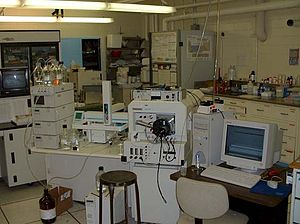- Triple quadrupole mass spectrometer
-
A triple quadrupole mass spectrometer is a tandem mass spectrometer consisting of two quadrupole mass spectrometers in series, with a (non mass-resolving) radio frequency (RF) only quadrupole between them to act as a collision cell for collision-induced dissociation. The first (Q1) and third (Q3) quadrupoles serve as mass filters, whereas the middle (q2) quadrupole serves as a collision cell. This collision cell is an RF only quadrupole (non-mass filtering) using an inert gas such as Ar, He, or N2 gas to provide collision-induced dissociation of a selected precursor ion that is selected in Q1. Subsequent fragments are passed through to Q3 where they may be filtered or scanned. This configuration is often abbreviated QqQ, here Q1q2Q3.
Contents
Structural mass spectrometry
This alignment of two mass spectrometers in succession with a collision quadrupole in between allows to elucidate the structure of the ionised sample molecules. Four main modes can be performed as follows.[1]
Product ion scan
- The first quadrupole Q1 is set to select an ion of a known mass, which is fragmented in q2. The third quadrupole Q3 is then set to scan the entire m/z range, giving information on the sizes of the fragments made. From the ion fragmentation information, the structure of the original ion can be deduced. This experiment is commonly performed to identify transitions used for quantification by tandem MS.
Precursor ion scan
- A certain product ion is selected in Q3, and the precursor masses are scanned in Q1. This experiment is selective for ions having a particular functional group (e.g., a phenyl group) released by the fragmentation in q2.
Neutral loss scan
- Both Q1 and Q3 are scanned together, but with a constant mass offset. This allows the selective recognition of all ions which, by fragmentation in q2, lead to the loss of a given neutral fragment (e.g., H2O, NH3). Similar to the precursor ion scan, this technique is also useful in the selective identification of closely related class of compounds in a mixture.
Selected reaction monitoring / Multiple reaction monitoring
- Both Q1 and Q3 are set to a selected mass, allowing only a distinct fragment ion from a certain precursor ion to be detected. A very selective analysis mode, which can increase sensitivity. If Q1 and/or Q3 is set to more than a single mass, this configuration is called multiple reaction monitoring.[2]
History
The arrangement of three quadrupoles was first developed by Morrison of LaTrobe University, Australia for the purpose of studying the photodissociation of gas-phase ions.[3] The first triple-quadrupole mass spectrometer was developed at Michigan State University by Enke and Yost in the late 1970s.[4]
References
- ^ de Hoffmann, E. (1996), "Tandem mass spectrometry: a Primer", Journal of Mass Spectrometry 31 (2): 129, doi:10.1002/(SICI)1096-9888(199602)31:2<129::AID-JMS305>3.0.CO;2-T
- ^ Anderson, L.; Hunter, C. L. (2006), "Quantitative Mass Spectrometric Multiple Reaction Monitoring Assays for Major Plasma Proteins", Molecular & Cellular Proteomics 5 (4): 573, doi:10.1074/mcp.M500331-MCP200, http://www.mcponline.org/content/5/4/573.full.pdf+html
- ^ Morrison, J. D. (1991), "Personal reminiscences of forty years of mass spectrometry in Australia", Organic Mass Spectrometry 26 (4): 183, doi:10.1002/oms.1210260404
- ^ Yost, R. A.; Enke, C. G. (1978), "Selected ion fragmentation with a tandem quadrupole mass spectrometer", Journal of the American Chemical Society 100 (7): 2274, doi:10.1021/ja00475a072, http://masspec.scripps.edu/mshistory/timeline/time_pdf/1978_YostRA.pdf
See also
- Hybrid mass spectrometer
Mass spectrometry Ion source Mass analyzer Detector MS combination MS/MS • QqQ • Hybrid MS • GC/MS • LC/MS • IMS/MSFragmentation 
This article about analytical chemistry is a stub. You can help Wikipedia by expanding it.

